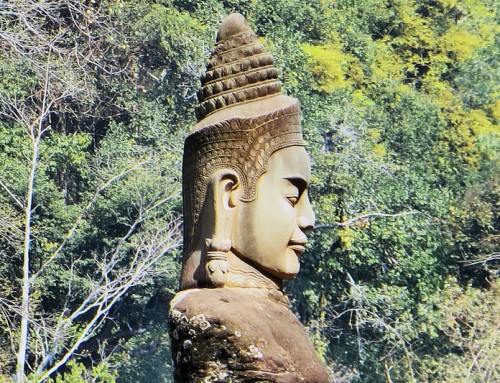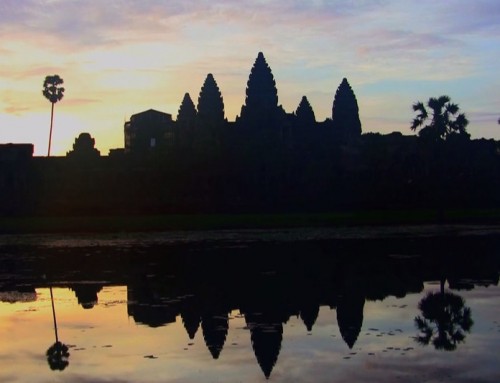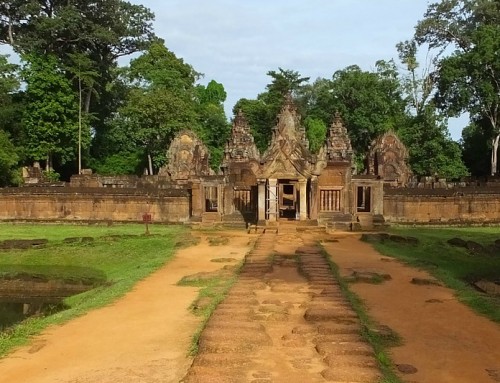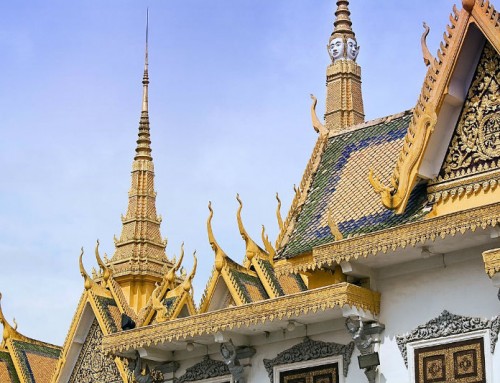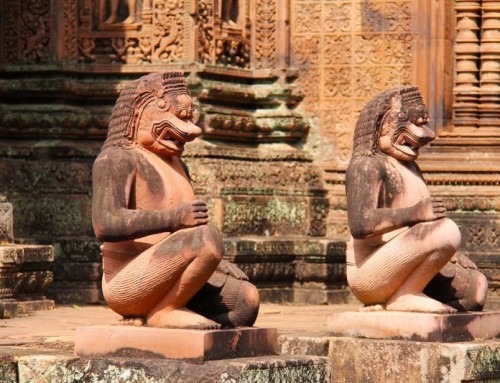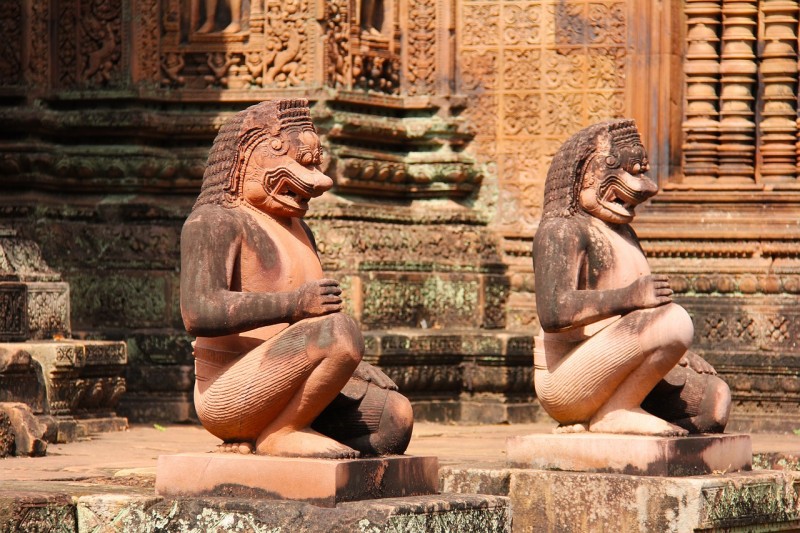
Day 01
Phnom Penh -, -, –
Arrival at Phnom Penh international airport and after immigration and customs formalities, meeting with the guide.
Transfer to hotel, where the check-in is generally provided at 14:00, however, if the rooms should be available before this time, guests will be accommodated as soon as possible.
Start the visit with the temple that gives the city its name, Wat Phnom: located atop a hill, attended by the faithful who come here to pray and get to predict the future by Continue to the Royal palace and Silver Pagoda, so called for more than five thousand silver tiles from which the floor is formed, all enriched by the gifts offered to the royal family from all over the world.
Lunch and dinner at leaisure.
Overnight.
.
Day 02
Phnom Penh – Battambang B, L, –
Breakfast at hotel.
Departure for Battabang, the second largest city in Cambodia, also called the capital of the west.
See, by one of the villages along the road, the technique of silver production as it is handed down for generations.
At the village of Kampong Chnang cover a stretch of the river leading to the Tonle Sap, seeing how life takes place in the floating villages made up of many boats, floating homes and facilities.
Continue on to Battambang, and arrival in the afternoon. The city still has a very provincial atmosphere and is marked by an architecture mixed between local and colonial styles, where people still live according to the customs of the traditional peasant culture. Situation permitting, sometimes the visit is not inpossible for technical reasons, have the chance to try a unique form of local transport, the Bamboo Train, stepping onto a small platform, precisely formed by bamboo anchored to the wheels that allow it to travel on the tracks of what was once a railway line, now abandoned, all powered by a small but powerful engine. If time permits, proceed to Ek Phnom, a striking Khmer sanctuary dating from the first half of the eleventh century, and useful for understanding the Angkorian architecture.
Lunch at local restaurant and dinner at leisure.
Overnight.
.
Day 03
Battambang – (Bantey Chmar – Sisophon) – Siem Reap B, L, –
Breakfast at hotel.
Depart for Siem Reap by local public boat from the small pier located in the center of town.
The boat departs following the Sangke river. Then on the river through a beautiful and unspoilt scenery: villages, pagodas, fishermen who use a particular technique through nets raised by a kind of pendulum catapult, mangroves and more that you can imagine and not, in a lush and untouched greenery. Arrive at the splendid floating village of Prek Toal where it ‘s possible, if required, and conditions permit, visit the school and a church float moored in the vicinity. Then enter in the Tonle Sap, so large that no one can see the shore. The boat carries on along the lake until the floating village of Chong Kneas where go down to the ground and reach Siem Reap by road after about thirty minutes. Arrival after about 9-10 hours by boat from Battambang, travel times are flexible, depending on water level and the conditions at the time. (The boats are local in wood, sometimes uncomfortable, due to rigid rotary internal use and not incan choose in advance, and the maximum capacityin of 30-35 people). Navigation is normally possible in the period from September to October to February-March. Transfer and accommodation at hotel.
A san alternative, Battambang – Siem Reap by land:
Depart early for Bantey Chmar passing through the town of Svay Sisophon, not far from the Thai border.
The temple of Bantey Chhmar is located about 60 km from the capital of Bantey Meanchey province. It is a little-known and visited monastic complex, which in practiceis not yet touched by any form of restoration.
Built between the late twelfth and the beginning of the thirteenth century, it was dedicated to the son of king Yayavaraman VII who fell fighting against the Champa.
The internal bas-reliefs of the outer wall depict scenes of the battles of that war. Bantey means town or city, and the complex is the size of a small town.
In the inner part vegetation grew luxuriantly, without completely taking over and the absence of tourists allows to relive the experience of the few travelers from the colonial period. Among the bas-reliefs, a representation of Awalokiteshwar, or Chenrezig in Tibetan, goddess representing the compassion and the tutelary deity of Tibet at the same time, allows to make risky but probably real connections, between these two so distant civilizationsin.
Lunch en route.
Continue and arrive by late afternoon in Siem Reap.
Dinner at leisure and overnight at hotel.
.
Day 04
Siem Reap B, L, –
Breakfast at hotel.
Departure for the visit of the pre-Angkorian Rolous archaeological complex, located about 15 km south-east from the town.
The temples of Prae Ko, Bakong and Lolei are the main and first to be built in the area during the ninth century, they represent the link between the kingdom of Chenla, whose capital were situated where now there are the remains of Sambor Preikuk and the new kingdom of Angkor, marking the beginning of the summit of power and Khmer art.
Then proceed to the Angkor complex and see the Prasat Kravan, the only example a the temple that consists of five towers in the line. In the middle see one of the most beautiful decorations dedicated to the god Vishnu.
In the afternoon visit the walled city of Angkor Thom, passing through the South Gate, and continuing to the spectacular temple of Bayon, which, with its more than two hundred enigmatic faces, is the central building, both in the location and in the design of the city itself.
It is a masterpiece from the amazing structure consisting of 54 towers and has beautiful bas-relief depicting the daily life at the time of the kingdoms of Angkor and in which they were counted more than ten thousand figures carved in stone.
Then continue by passing in front of the imposing Baphuon and see the pyramid-shaped temple linked to the legend and the king and the snake, Pimeanakas, then to the area where the Royal Palace was located and end with the beautiful Terrace of the Elephants and Leper King.
Lunch at local restaurant and dinner at leisure.
Overnight.
.
Day 05
Siem Reap B, L, –
Breakfast at hotel.
Excursion to discover the Bantey Srey temple, which means the citadel of women, famous for the beautiful bas-reliefs carved in almost all pink sandstone and considered by many, even greater delicacy and precision to those found in Angkor Wat.
The temple is located about 40 km from Siem Reap and it is reached while passing through an enchanting landscape characterized by rice fields and villages.
Before returning, visit the temple of Bantey Samre, named after the legend of the peasant who became king.
In the afternoon proceed to the Bantey Kdey temple, also called the citadel of the cells that served as a meditation retreat for Buddhist monks. After admiring the reservoir of Shree Shrang or royal bath, climb the mountain temple of Pre Rup that marks the beginning of a new era in the Khmer architecture. It is built in red bricks and it is’ particularly impressive at sunset time, when the reddish bricks are constantly changing their colours.
Lunch at local restaurant and dinner at leisure.
Overnight.
.
Day 06
Siem Reap B, L, –
Breakfast at hotel.
Part of the morning spent at Angkor Wat, the masterpiece of all Khmer art, the most famous and impressive temple in the area, considered one of the wonders of the world.
It is a structure that dazzles in its spectacular, extraordinary example of architectural wisdom, decorated with extremely refined sculptures and bas-reliefs, through which the main scenes of the Indian epics are described in masterly fashion.
In the afternoon proceed to visit part the Grand Circuit of Angkor, beginning with the vast and majestic temple of Prae Khan, also known as the temple of the Holy Sword, which had the functions of a religious and cultural centre and, for a period, it was also used as royal residence. At its maximum development, more than ten thousand people were living in the compound, including many of the important teachers and the Apsara dancers, the celestial dancers.
Continue to Neak Pean, the only circular structure in memory of a mythical lake which arise from the four rivers of Hindu mythology. At the time this sacred space was used as a place of purification by water.
Then head to one of the most suggestive and fascinating temples, the Ta Phrom,
It is totally immersed in the jungle and deliberately left in same condition as when it was discovered by French archaeologists in 1860.
Partially covered by vegetation, the roots of trees magically embrace the sculptures and stone blocks of galleries, signing a marriage between history and the unbridled force of nature itself.
Lunch at local restaurant and dinner at leisure.
Overnight.
.
Day 07
Siem Reap – Beng Melia – Ko Ker – Pre Vihear B, L, –
Breakfast at hotel.
At about sixty kilometers from Siem Reap is the largest complex of Beng Melea, a temple with an adjoining monastery nestled in the jungle, which covers an area of over one square km.
Built in the same style and by the same king who built Angkor Wat, Beng Melea is considered by many may actually also to have been a prototype of the great temple.
Being devoid of carvings, it is thought to have been completed painted to be ‘internal to’ outside.
Most of the monastic complex has not been restored and the atmosphere is fantastic.
With the exception of the Ta Phrom, this complex offers the best shots of vegetation and large trees integrated into the temple.
After continuing for another seventy Km or so, arrival in Ko Ker, another complex of many temples and monasteries, the most important of which contains a large pyramid of seven steps which leaves very puzzled by the similarity with other sites of that period, many thousands of miles away.
Koh Ker was the capital of the Khmer empire for twenty years, in the ninth century. Now many of the ruins are still being immersed in the jungle and seldom visited, they are able to retransmit that particular charm that stunned the visitors a few decades ago and left them speechless.
Continue then to Pre Vihear area.
Arrival and accommodation.
Lunch box.
Dinner at leisure and overnight
.
Day 08
Pre Vihear – Sambor Preikuk – Kampong Thom B, L, –
Breakfast at hotel.
Il territorio su cui sorge il tempio e stato a lungo conteso tra Cambogia e Thailandia fino a quando, nel 1963 , un tribunale internazionale lo attribuì alla Cambogia .
La posizione del tempio, esattamente sulla cresta della montagna , da cui si gode di una vista mozzafiato sulla Cambogia , la Thailandia e addirittura il Laos, lo pone in una categoria assolutamente a se stante rispetto a tutti i templi Khmer .
Il tempio e’ formato da un grande complesso costruito su quattro livelli che comprende cinque padiglioni d’entrata ( Gopura ) e una residenza reale con due ali, che probabilmente servivano anche da rifugio ai pellegrini .
Tra una Gopura e l ‘altra ci sono dei lunghi cortili affiancati dai Naga e a lato di uno di essi c’e’ la grande cisterna dell’ acqua che serviva i pellegrini e gli abitanti del tempio.
La costruzione di tutto il complesso si e protratta per oltre duecento anni a partire dalla fine del IX secolo , periodo in cui Ko Ker e’ stata capitale del regno Khmer ( 921-942).
Nel 2004 il governo di Phnom Phen ha inaugurato una nuova strada dal fondovalle che si aggiunge alla vecchia strada costruita dai Khmer rossi verso la meta degli anni ’80 in piena guerra civile, rendendo l’ accesso al tempio relativamente facile anche dal versante cambogiano .
L’escursione al tempio di Prasat Phre Viher sarà veramente unica e indimenticabile .
Departure towards the province of Kampong Thom.
Then head to Sambor Preikuk, the most ‘important pre-Angkorian archaeological complex of the Country, representing the ancient capital of the kingdom of Chenla, the precursor of the Khmer empire.
There are over a hundred temples of great beauty and rarely visited, divided into three monastic complex: the South Group of Prasat Yeay Poan, the Central Group of Prasat Tor and the North Group of Prasat Sambor.
This latter includes the most important buildings and is’ dedicated to an incarnation of Shiva.
If, for lack of time, the visit to Sambor Preikuk could not be done this day, the same will be postponed to the next day.
Lunch at local restaurant and dinner at leisure.
Overnight.
.
Day 09
Kampong Thom – Kratie B, L, –
Breakfast at hotel.
Departure to Kratie
Kratie is the province of the dolphin, and even if it is over 600 km. from the sea, the location is famous for being the city where there are more river dolphins that anywhere else in the world
Or so said a description of the colonial period, now maybe it is not more so, but there’ in any case the chance to meet the Irrawady river dolphins.
The town is big enough to have a couple of acceptable hotels and good restaurants which also provide European cuisine. In colonial times this was the capital of the whole north of the country and traces of this period are visible everywhere in the form of the roads and the residences of the lords of rubber. There are markets for all goods which remind us a bit of our emporiums time. Many traditional Khmer houses remind us of the ancient glories of this inland waterway market.
Visit the side of the river where the largest number of dolphins gathers and boat trip in order to better approach and admire these so rare mammals.
Proceed the town and its surroundings, then continue on seeing the temple of Phnom Sombok until sunset on the Mekong River.
Lunch at local restaurant and dinner at leisure.
Overnight.
.
Day 10
Kratie – Rattanakiri B, L, –
Breakfast at hotel.
Leaving for the province of Rattanakiri and arrival in the afternoon.
Banlung is the capital of the province of Rattanakiri. Vast plantations of rubber trees are nearby in a radius of at least fifteen Km.
In the most remote areas, the forest is still inhabited by large rare mammals such as tigesr, wild elephants, leopards, rhinos and even a kind of cow locally named Kouprey that seems to exist only in Cambodia. At several locations around the town there are places where precious stones are searched, generally zircons and garnets.
Waterfalls and volcanic lakes break up the great green forest where people can venture with confidence, for excursions on elephant back, on foot or by jeep, accompanied by the experienced rangers of the park. A volcanic crater lake is close to town that it could even be used as a pool. The lake is perfectly round shaped, is about 50 meters deep and the water on the surface is absolutely clear and transparent A volcanic crater lake is close to town that it could even be used as a pool. The lake which is perfectly round shaped, is about 50 meters deep and the water on the surface is absolutely clear and transparent. Escorted by the guides and in absolute safety it is possible to hike along the rivers and meet local tribe people with pre-Buddhist burial traditions unique in the world. They bury their dead by building monuments that are very similar to the deceased persons.
At Banlung market bows and arrows are still sold, new stuff, with no pretense of being tourist souvenirs, which shows that many forest peoples have not yet become farmers.
The whole area surrounding Banlung is full of eco-tourism opportunities. In the city there is also the chance to visit the interesting plant that starts the initial processing of the rubber formation.
Lunch at local restaurant and dinner at leisure.
Overnight.
.
Day 11
Rattanakiri B, L, –
Breakfast.
Depart towards the tribal cemeteries which are located north of Banlung. After about thirty kilometres board a boat along a tributary river of the Mekong and arrive at these minorities that keep absolutely unique rituals in the world and build equally unique tombs.
Return and visit the volcanic lakes, which are perfectly round with a depth of 50 meters and offer bathing possibilities.
Lunch en route and dinner at leisure.
Overnight.
.
Day 12
Rattanakiri – Mondulkiri B, L, –
Breakfast at hotel.
The start the journey to Mondulkiri
The trip runs entirely through a totally primordial jungle, one of the last remaining in South East Asia. The views of the completely pristine jungles and mountains will remain in the hearts of all the few adventurers who pass through these lands. Sen Monorom is the capital of the province of Mondulkiri. Located about 900 meters above sea level with its 6000 inhabitants, this is the smallest provincial capital of the country The province is very vast and since just a few years, the government is doing to encourage a policy of ‘migration in these areas.
Here again, the forests, the few remaining indigenous tribes and the many beautiful waterfalls surrounded by a primordial and untouched nature, are the attraction for the few who venture into these remote lands, still visited by a very low number of passengers willing to endure some discomfort in order to live a few days in one of the last unspoiled areas of the world.
The population of this vast province counts only about forty thousand inhabitants. The two main minority groups represent more than half of the population and this means that the Khmer are the minority in this province. Certainly many wild animals including tigers, bears, leopards, elephants, buffalo and who knows how many other live in these remote forests.
Lunch at local restaurant and dinner at leisure.
Overnight.
.
Day 13
Sen Monorom (Mondulkiri) B, L, –
Breakfast at hotel.
Visit an elephant conservation project. Elphant Valley Project.
Transfer to the project and then spend a morning with the elephants, following them into the jungle and learning to know them, seeing how drivers of local elephants behave in the forest and understanding conservation.
It is necessary to bring enough water (at least one liter) throughout the morning. It may also be necessary to wear sunscreen, a hat, a mosquito repellent, a waterproof jacket, etc.
You should wear appropriate clothing to staying in the jungle, such as long pants and a t-shirt.
Please do not wear shorts, short skirts, short skirts or dresses, visible neckties, straps, etc for respect for the local culture of Bunong staff who is employed in the project.
You need to wear suitable footwear, flip flops and slippers are not suitable for hiking in the forest.
Transfer to the beautiful Bousra Waterfall and chance to bath in the area.
Departure for a Phnong village situated about seven kilometers from town,
Lunch en route and dinner at leisure.
Overnight.
.
Day 14
Mondulkiri – Wat Nokor – Phnom Penh B, L, –
Breakfast at hotel.
Departure heading towards the provincial capital of Kampong Cham, a small town nestled along the banks of the Mekong.
Pass through vast rubber trees plantations, which are present in the area since the French colonial period, and stop to see the process of extraction of the substance.
Visit the temple of Wat Nokor, dating from the eleventh century, a temple built with a modern Mahayana and Hinayana pagodas
After a short drive, break at Skhun village, famous for its edible giant spiders, cooked in many ways for whoever dares to taste them, which are served just in all ways to those who want it of course,.
Continue to Phnom Penh.
Arrival and accommodation.
Lunch at local restaurant and dinner at leisure.
Overnight.
.
Day 15
Phnom Penh B, L, –
Breakfast at hotel.
Then proceed to the Toul Sleng, the prison museum tragic witness to the bloody regime of the Khmer Rouge and the genocide perpetrated against the Cambodian people themselves, guilty of being able to read and write, wear glasses, be teachers, doctors, professionals, speak foreign languages, it is estimated they have been tortured and killed about three million people over twelve in four years until 1979.
If time permits continue to the famous Russian market, consisting of a series of intricate corridors and passages where a myriad of stalls and sellers may be overlooked and where all kinds of merchandise is displayed to potential buyers.
Lunch at local restaurant
Transfer to the airport in time for the departure of the scheduled flight.
End of services.
-
Transfers and excursions by air conditioned private vehicles as per program, except where open line boats are provided.
-
Private English speaking guides, other languages with supplement.
-
Assistance, availability and regular visits to customers by dedicated and resident staff.
-
Entrance fees.
-
Accommodation as per requested hotels.
-
Meals as per program.
-
New taxes and entrance fees.
- Any kind of insurances
- Drinks at meals (if any) and extras in general

